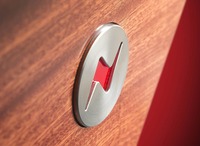
Review by George Shilling
Without doubt, Mackie mixers have empowered an army of musicians and DJs to record their efforts with greater control and flexibility than could ever be imagined ten years ago. They are by no means the only company producing such products, but with the power of a well-oiled marketing machine and copywriters with a good understanding of the issues, not to mention a great sense of humour, they have captured the imagination of the semi-professional recording market. The sound-reinforcement industry has also provided homes for many of these desks.
The 1604-VLZ Pro is the latest incarnation of the original CR1604. The main benefit of the latest upgrade to the '16/4/2' format Mackie is the inclusion of superior microphone amplifiers on every channel, designated XDR (for extended dynamic range). For studio recording, owners of budget desks often employ a high quality outboard microphone channel for overdubbing, but when tracking with multiple microphone sources, one often has little choice but to employ the mixer's microphone amplifiers. This new design enables Mackie to boast some remarkable figures, with huge dynamic range of 130dB and extremely low noise and distortion. On paper, these are as good as many outboard microphone amplifiers costing more than the price of this entire mixer.
For the asking price, the Mackie offers a large array of features. This desk will typically be used with one of the popular digital 8-track tape machines, and Mackie have provided for this scenario by labelling faders 9-16 as tape returns 1-8. Also to this end, direct outputs appear for channels 1-8. All sixteen channels are otherwise identical. Below the Gain pot, they each feature six Aux Sends, the first two of which boast individual pre/post switches and master level controls. Sends 5 and 6 share the controls for 3 and 4 by the flip of a switch on each channel. The three-band EQ on each channel features a sweepable mid and a high-pass filter at 75Hz and is okay for basic EQing, but fairly unrefined as one might expect at this price bracket. The only way to bypass the EQ is to line up the gain pots with their subtle centre détentes. A Panpot is located next to a large channel Mute switch, whilst the fader is accompanied by routing switches to busses 1 & 2, 3 & 4, and L-R mix, along with a solo button. An ingenious dual LED system shows signal present and overload (clip), which is very useful when you do not have a meter bridge. The 'signal present' LED glows brighter to indicate Solo mode, and the overload light doubles as a mute indicator.
I found all the pots and faders stiffer than I remember from the last time I used a Mackie, but perhaps they loosen with use. Legending on the surface is remarkably good, considering how tightly crammed the controls are. However, I found myself constantly eyeing up the control surface from a low angle to make sure none of the shallow buttons were inadvertently depressed, and additional vertical travel for these would certainly be helpful.
The right hand section includes Aux Returns' level controls, solo mode and level, monitoring controls, which even include an external stereo input. The effects returns and send masters include some neat little routing features to get you round tricky situations, especially when setting up musicians' monitoring.
The four Group Masters feature useful routing buttons to L and R mix, and there is a socket for headphone output conveniently located near the main fader.
The whole mixer is quite weighty, (the power supply is internal), but packs in a lot for its compact size. The rear panel is described as the patchbay, which is not exaggerating the case at all, as there are nearly all the connections you could want taking up the whole surface of the panel. Non-latching Neutrik XLR inputs are provided for the microphone inputs, along with a global phantom power switch. Balanced jack line inputs and unbalanced TRS Insert sockets are also provided. . Rack ears for the desk are included, the width of the 1604 being a convenient standard 19" width. One notable feature is the ability to rotate the patchbay pod to different positions to make it more easily accessible for any given situation. However, an optional piece of hardware must be obtained to enable location of the connections to the same plane as the control surface.
Jeff Gilbert's manual, just like the advertising, is chatty, good-humoured and boastful. Lots of clear diagrams and plenty of sensible advice are included.
In use, there is little to grumble about, even for a user familiar with large-scale high-end desks. Outputs are all at +4dB, operation is very intuitive, and a number of neat little features help out in awkward situations. As for the new microphone amplifiers, they sound excellent. On vocals, they were noticeably more open sounding than a competitor's older design, and absolutely as clean and quiet as the figures suggest, certainly comparing favourably with other solid state units.
All in all, Mackie have struck upon a great formula with a good balance of features and performance for a bargain price.
Reproduced with kind permission from www.georgeshilling.com. Copyright ©



